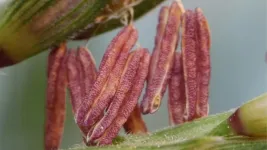Having higher than usual blood sugar levels at the time of hospital admission for an ischemic stroke significantly increases the risk of a poor functional prognosis or death within three months of the stroke. This is the main conclusion of a study by the Endocrinology and Nutrition Services and the Neurology Department of Hospital del Mar, with researchers from the hospital's Research Institute, the RICORS-ICTUS network, and the CIBER of Diabetes and Associated Metabolic Diseases (CIBERDEM). The study is published in the journal Cardiovascular Diabetology and will continue with further studies to determine the utility of this factor in treating patients with this pathology.
It is known that the inflammatory state in certain diseases can cause increased blood sugar levels, or hyperglycemia, which can influence prognosis. In the case of ischemic stroke, this increase is common, but it has not been analyzed in depth. The Hospital del Mar study delves into this issue, reviewing data from 2,774 patients with this condition. Besides blood sugar levels at the time of admission and their comparison with each patient’s usual levels, other variables were considered, such as age, diabetes, disability, stroke severity, and treatment received.
Considering these variables, higher blood glucose levels compared to usual were confirmed as a factor for worse functional prognosis and mortality three months after the stroke, independently of other factors. An increase of just 13% above usual levels worsens the prognosis, regardless of the glucose level. This was also observed in patients who previously had diabetes, accounting for 35% of the total studied.
Dr. Elisenda Climent, associate doctor of the Endocrinology and Nutrition Service at Hospital del Mar and researcher at its Research Institute, points out, “This variable better reflects the effect of sugar at the time of patient admission, and in the group of patients with higher indices, there is a worse prognosis and mortality.” Specifically, for every 10% increase, the risk of a worse prognosis rises by 7%. In those with higher levels, this risk increases by 62%, and mortality risk by 88%.
Continuing the Line of Study
Researchers plan to continue studying the effect of sugar in this population to determine if it is beneficial to act on glucose levels. Currently, it is not done due to the risks associated with excessive lowering of glucose levels. “A more conservative treatment approach is currently chosen, as strict control strategies have not proven superior due to the risks posed by glucose drops for patients' conditions. At present, sugar is not aggressively treated in patients who have had an ischemic stroke. Our study may allow for selecting the population that can be worked on more intensively, leveraging new technologies for safer monitoring,” explains Dr. Ana Rodríguez, head of the stroke section of the Neurology Service and researcher at the Research Institute of Hospital del Mar.
To do this, new studies will be conducted. “It is necessary to study whether it is a severity marker, acting on which does not improve the prognosis, or whether it is a factor that can be worked on to improve the condition of patients with higher than usual glucose levels,” says Dr. Juan José Chillarón, head of the Endocrinology and Nutrition Service at Hospital del Mar and researcher at its Research Institute. All this could allow “this subgroup of patients to benefit from more intensive insulin therapy, which could be a potential conceptual change in their approach,” notes researcher Joan Jiménez Balado from the Research Institute of Hospital del Mar.
END
Higher glucose levels worsen prognosis in ischemic stroke patients
A 10% increase in blood sugar levels from the usual raises the likelihood of a poor prognosis by 7% and the chance of death by 10% within three months of the stroke, according to a study published in Cardiovascular Diabetology
2024-08-07
(Press-News.org)
ELSE PRESS RELEASES FROM THIS DATE:
USC Norris Comprehensive Cancer Center to Open Radiation Oncology and Imaging Center in Newport Beach
2024-08-07
LOS ANGELES — USC Norris Comprehensive Cancer Center, part of Keck Medicine of USC, will open a Newport Beach location offering the latest advancements in radiation therapy and diagnostic imaging. The treatment center, which will open in early 2025, will feature cutting-edge cancer technologies that are yet to be available in Orange County, providing new therapeutic options and optimizing patient outcomes.
The new location address is 4590 MacArthur Blvd. in Newport Beach, less than 15 minutes away from USC Norris’ oncology centers in Newport Beach and Irvine. Those centers are staffed by respected oncologists who have served Orange County for decades, ...
MD Anderson Research Highlights for August 7, 2024
2024-08-07
HOUSTON ― The University of Texas MD Anderson Cancer Center’s Research Highlights showcases the latest breakthroughs in cancer care, research and prevention. These advances are made possible through seamless collaboration between MD Anderson’s world-leading clinicians and scientists, bringing discoveries from the lab to the clinic and back.
Recent developments at MD Anderson include insights into evolutionary cellular adaptations to environmental stressors, potential targets to overcome trouble swallowing in head and neck cancer patients treated with radiation therapy, a promising chemotherapy-free ...
Some e-cigarette chemicals mimic nicotine, possibly bypassing regulation
2024-08-07
DURHAM, N.C. – In what appears to be an effort to bypass public health regulations covering vaping products, some tobacco companies have begun replacing nicotine in e-cigarettes with related chemicals that have similar properties but unknown health effects, Duke Health researchers report.
In a research letter appearing Aug. 7 in JAMA, study authors at Duke and Yale University also found that the quantity of these chemicals, known as nicotine analogs, are not accurately disclosed on the packaging.
“Vaping products containing nicotine are subject to federal laws that prohibit sales to people under the age of 21,” said study co-author Sairam V. Jabba, ...
New 400-year temperature record shows Great Barrier Reef is facing catastrophic damage, researchers warn
2024-08-07
The Great Barrier Reef is under critical pressure, with warming sea temperatures and mass coral bleaching events threatening to destroy the remarkable ecology, biodiversity, and beauty of the world’s largest coral reef, according to new research published today.
‘Highest ocean heat in four centuries places Great Barrier Reef in danger’, published in Nature (8 August), led by University of Wollongong (UOW) Honorary Fellow and University of Melbourne Lecturer Dr Benjamin Henley, provides new evidence of the impact that rising sea surface temperatures ...
Corn’s ‘missing link’
2024-08-07
Cold Spring Harbor Laboratory (CSHL) has begun to unravel a mystery millennia in the making. Our story begins 9,000 years ago. It was then that maize was first domesticated in the Mexican lowlands. Some 5,000 years later, the crop crossed with a species from the Mexican highlands called teosinte mexicana. This resulted in cold adaptability. From here, corn spread across the continent, giving rise to the vegetable that is now such a big part of our diets. But how did it adapt so quickly? What biological mechanisms allowed the highland crop’s traits to take hold? Today, a potential answer emerges.
CSHL Professor and HHMI Investigator Rob Martienssen had ...
Scientists uncover hidden forces causing continents to rise
2024-08-07
Scientists at the University of Southampton have answered one of the most puzzling questions in plate tectonics: how and why ‘stable’ parts of continents gradually rise to form some of the planet’s greatest topographic features.
They have found that when tectonic plates break apart, powerful waves are triggered deep within the Earth that can cause continental surfaces to rise by over a kilometre.
Their findings help resolve a long-standing mystery about the dynamic forces that shape and connect some of the Earth’s most ...
Variability in constituents of e-cigarette products containing nicotine analogues
2024-08-07
About The Study: Discrepancies were observed between labeled and measured concentrations of nicotine analogues in e-cigarettes and e-cigarette liquids marketed as nicotine replacements and exempt from FDA’s regulatory purview. Such discrepancies may lead to uncertainty about user exposure. When coupled with the largely unknown acute and chronic inhalation hazards and addictive potential of nicotine analogues, assessing product risk based on exposure becomes challenging from a clinical and regulatory standpoint. With e-cigarettes increasingly considered for smoking cessation, the advent of nicotine analogue–containing products with ...
A vaping cessation text message program for adolescent e-cigarette users
2024-08-07
About The Study: A tailored, interactive text message intervention increased self-reported vaping cessation rates among adolescents recruited via social media channels.
Quote from corresponding author Amanda L. Graham, PhD:
“Health care providers, teachers, and parents have been asking how to help teens quit vaping. This study is a critical breakthrough that demonstrates the power of a behavioral intervention for vaping cessation. Text messages serve as powerful reminders of an initial commitment to quit and can deliver proven behavior change support right to a young person’s phone.
“We also did not see evidence that teens who quit ...
Neighborhood socioeconomic disadvantage across the life course and premature mortality
2024-08-07
About The Study: Low neighborhood socioeconomic status was associated with premature mortality in this study. The risk of premature mortality was greatest among individuals experiencing persistently low neighborhood socioeconomic status from young to middle adulthood. Place-based interventions that target neighborhood social determinants of health should be designed from a life course perspective that accounts for early-life socioeconomic inequality.
Corresponding Author: To contact the corresponding author, Wayne R. Lawrence, DrPH, email wayne.lawrence@nih.gov.
To access the embargoed ...
Cocaine discovery could pave way for treatment for substance abuse
2024-08-07
You have probably heard of dopamine. The substance also known as the “feel-good hormone”.
Drugs such as cocaine cause a surge of dopamine in the brain. Normally, a protein in the brain called the dopamine transporter (DAT) helps regulate dopamine levels and prevent the brain from thinking that every experience is pleasurable.
However, when affected by cocaine, the brain is unable to regulate dopamine levels. Previously, researchers did not know how cocaine affects the different transporters in the brain, but a new study from the University of Copenhagen has changed that.
“We have learned how cocaine binds to the dopamine transporter, which is ...
LAST 30 PRESS RELEASES:
School meals could unlock major gains for human and planetary health
Menopause hormone therapy does not appear to impact dementia risk
Signature patterns of brain activity may help predict recovery from traumatic brain injury
Dresden study uncovers new key mechanism in cancer cells
New species are now being discovered faster than ever before, study suggests
Cannabis-based products show limited short-term benefit for chronic pain, with increased risk of adverse effects
Cannabis products with more THC slightly reduce pain but cause more side effects
Clearing the brain of aging cells could aid epilepsy and reduce seizures
Brain injuries linked with potential risk of suicide, new study finds
New technique lights up where drugs go in the body, cell by cell
New study finds movement of fishing fleets can reveal shifts in marine ecosystems
Embargoed: New evidence points to potential treatment for vascular dementia
Study uncovers disrupted brain balance in alcohol dependence
Working in groups can help Republicans and Democrats agree on controversial content moderation online
Structural findings reveal how distinct GPCR ligands create different levels of activation
Anything-goes “anyons” may be at the root of surprising quantum experiments
UC review: Maximizing workplace opportunity for veterans
From generation to complex control: Metasurfaces make perfect vortex beams "within reach"
Thin-film lithium niobate-based detector: recent advances and perspectives
Exploring why some people may tend to persistently make bad choices
How cells balance their protein levels
Nirsevimab vs RSVpreF vaccine for RSV–related hospitalization in newborns
Effectiveness and impact of maternal RSV immunization and nirsevimab on medically attended RSV in US children
AI gives scientists a boost, but at the cost of too many mediocre papers
Next-generation vision model maps tree growth at sub-meter precision
Genes aren’t destiny for inherited blindness, study shows
MIT study: High-fat diets make liver cells more likely to become cancerous
Exposure to multiple fine particulate matter components and incident depression in the US Medicare population
Risk of burdensome health care spending over time in the US
Nirsevimab against hospitalizations and emergency department visits for lower respiratory tract infection in infants
[Press-News.org] Higher glucose levels worsen prognosis in ischemic stroke patientsA 10% increase in blood sugar levels from the usual raises the likelihood of a poor prognosis by 7% and the chance of death by 10% within three months of the stroke, according to a study published in Cardiovascular Diabetology


